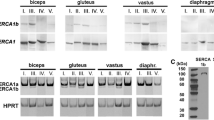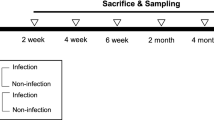Summary
Different arrangements of coxsackievirus A1 in striated muscle of new born mice display different fates of the virus progeny:
-
1.
Two-dimensional crystals and rows of virus particles between membranes represent the mechanism, by which virus is continuously released from the cell. Such formations are always found at the periphery of the cell, virions being thereby transported more or less directly from a nuclear pore to the sarcolemm. By this way, infection is spread from one cell to another.
-
2.
Larger or smaller virus crystals in vacuoles are non-released virions, which have been accidentally trapped by autophagic vacuoles. Later on they are converted into phosphatase positive autolysosomes.
The possible sites of virus synthesis as well as some aspects of cellular defense are discussed.
Similar content being viewed by others
References
Amako, K., andS. Dales: Cytopathology of mengovirus infection. II. Proliferation of membranous cisternae. Virology32, 201–215 (1967b).
Anzai, T., andY. Ozaki: Intranuclear crystal formation of poliovirus: electron microscopic observations. Exp. molec. Path.10, 176–185 (1969).
Baltimore, D., H. J. Eggers, andI. Tamm: Altered location of protein synthesis in the cell after poliovirus infection. Biochim. biophys. Acta (Amst.)76, 644–646 (1963).
Becker, Y., S. Penman, andJ. E. Darnell: A cytoplasmic particulate involved in poliovirus synthesis. Virology21, 274–276 (1963).
Bienz, K., G. Bienz-Isler, M. Weiss, andH. Loeffler: Identification and arrangement of coxsackievirus A1 in muscles of newborn mice. Brit. J. exp. Path.50, 471–474 (1969).
Burnet, F. M.: Principles of Animal Virology. Acad. Press (1955).
Choppin, P. W.: On the emergence of influenza virus filaments from host cells. Virology21, 278–281 (1963).
Dales, S., H. J. Eggers, I. Tamm, andG. E. Palade: Electron microscopic study of the formation of polioviras. Virology26, 379–389 (1965).
De Duve, C., andR. Wattiaux: Functions of lysosomes. Ann. Rev. Physiol.28, 435–492 (1966).
Flanagan, J. F.: Hydrolytic enzymes in KB cells infected with poliovirus and herpes simplex virus. J. Bact.91, 789–797 (1966).
Fogh, J., andD. C. Stuart: Intracytoplasmic crystalline and non-crystalline patterns of coxsackievirus in FL cells. Virology9, 705–708 (1958).
Gomori, G.: Microscopic Histochemistry. Univ. Chicago Press (1952).
Holland, J. J., andD. W. Bassett: Evidence for cytoplasmic replication of poliovirus ribonucleic acid. Virology23, 164–172 (1964).
Horne, R. W., andJ. Nagington: Electron microscopic studies of the development and structure of poliomyelitis virus. J. molec. Biol.1, 333–338 (1959).
Hoyle, L.: The release of influenza virus from the infected cell. J. Hyg. (Lond.)52, 180–188 (1954).
Jezequel, A. M., andJ. W. Steiner: Some ultrastructural and histochemical aspects of coxsackievirus-cell interactions. Lab. Invest.15, 1055–1083 (1966).
Levy, H. B.: Intracellular sites of poliovirus reproduction. Virology15, 173–184 (1961).
Mattern, C. F. T., andW. A. Daniel: Replication of poliovirus in HeLa cells. Electron microscopic observations. Virology26, 646–663 (1965).
Mattern, C. F. T., andL. Li Chi: Studies on the sites and kinetics of coxsackie A9 virus multiplication in the monkey cell. Virology18, 257–265 (1962).
Penman, S., Y. Becker, andJ. E. Darnell: A cytoplasmic structure involved in the synthesis and assembly of poliovirus components. J. molec. Biol.8, 541–555 (1964).
Penman, S., K. Scherrer, Y. Becker, andJ. E. Darnell: Polyribosomes in normal and poliovirus infected HeLa cells and their relationship to messenger RNA. Proc. nat. Acad. Sci. (Wash.)49, 654–662 (1963).
Ruska, H., D. C. Stuart, andJ. Winsser: Electron microscopic visualization of intranuclear virus-like bodies in epithelial cells infected with poliomyelitis virus. Arch. ges. Virusforsch.6, 379–388 (1963).
Stuart, D. C., andS. Fogh: Micromorphology of FL cells infected with polio- and coxsackie viruses. Virology13, 177–190 (1961).
Tenenbaum, E.: Changes in cellular nucleic acids during infection with poliomyelitis virus as studied by fluorescence microscopy. Nature (Lond.)180, 1044–1045 (1957).
Willems, M., andS. Penman: The mechanism of host cell protein synthesis inhibition by poliovirus. Virology30, 355–367 (1966).
Wolff, D. A., andA. C. Bubel: The disposition of lysosomal enzymes as related to specific viral cytopathic effects. Virology24, 502–505 (1964).
Author information
Authors and Affiliations
Rights and permissions
About this article
Cite this article
Bienz, K., Bienz-Isler, G., Egger, D. et al. Coxsackievirus infection in skeletal muscles of mice an electron microscopic study II. Appearance and fate of virus progeny. Archiv f Virusforschung 31, 257–265 (1970). https://doi.org/10.1007/BF01253760
Received:
Issue Date:
DOI: https://doi.org/10.1007/BF01253760




